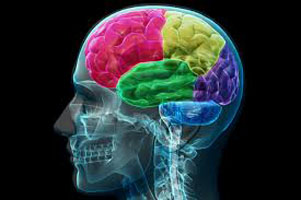
Perhaps you’ve had the following experience: Your new beau showered you with so much attention and affection that you fell in love. Then, slowly or quickly, your partner became deceitful, mean, disparaging and maybe even violent. You were shocked, angry and heartbroken, so you distanced yourself. But after a while, your memory of the bad behavior faded, and you just thought of the good times. You still love the abuser and want to reunite.
How is this possible? When your romantic partner lies, cheats, betrays, exploits or abuses you, how can you ever forget that, and why would you return for more?
The explanation is rooted in biology. Dr. Liane Leedom, a psychiatrist and professor of counseling at the University of Bridgeport, explains exactly what happens in the free Lovefraud webinar, Your first step towards real recovery from narcissistic abuse and trauma.
Essentially, when you are in love with an abuser, you form two different images of the person in your mind — one of the attentive, affectionate man or woman whom you fell in love with, and the other of the destructive person who hurt you.
The two images are stored in two different places in your brain, which makes it very difficult to reconcile them.
Brain circuits
So here’s the biology. Your incredibly complex brain has phenomena called neural circuits. A circuit is a set of interconnected components that serve a specific function.
According to a journal article, “A neural circuit may comprise a network of interconnected brain regions that together integrate vast amounts of information and perform more complicated cognitive and regulatory functions.”
For example, you have a brain circuit that deals with love and pleasure. This is different from the brain circuit that pays attention to threats, abuse and fear.
“In the context of abuse, the image that your mind forms of the person that you love is stored in two different brain circuits,” Dr. Leedom explains. “There’s one image that’s stored in the circuit where you feel love for that person, and there’s another image stored in the circuit where you experienced abuse from that person.”
In your brain, therefore, the loving partner and the abuser feel like different people.
Psychological bonds
A relationship is essentially a psychological bond that we form with another person. The bond forms in the beginning of the involvement because of pleasure. Your brain actually changes to accommodate the bond.
“When you feel like you love someone, part of that person is in your brain,” Dr. Leedom says.
If you’re involved with a sociopath (someone diagnosed as a narcissist, antisocial or psychopath), sooner or later your partner becomes abusive. He or she deceives, exploits or betrays you. What happens? The bad treatment you experience has the perverse effect of strengthening the psychological bond that you feel. Over time, it can become a trauma bond.
Trauma bonds
Trauma bonds are caused by two aspects of the relationship, according to research. The first is a power differential — one person in the relationship has more power than the other. One person can be stronger, wealthier or more aggressive.
Or, one person simply cares less. The person who is willing to walk away from the relationship typically has more power.
The second aspect that leads to trauma bonds is intermittent good and bad treatment. Sometimes your partner is wonderful, and sometimes he or she is hurtful. You never know how you will be treated, so you keep trying to please your partner, which creates the trauma bond.
This is why people in domestic violence situations have a hard time leaving. Their partner may beat them up, then profusely apologize, over and over. With every cycle of good and bad treatment, the trauma bond intensifies.
Your split brain
When you’re abused or hurt, the incident is fresh in your mind and you distance yourself from the abuser. But after some time, the pain from the hurt wears off.
“Guess what happens? The love circuit takes over again,” Dr. Leedom says. “And when the love circuit is active in your mind, you don’t remember the pain. The emotion associated with the abuse is gone and you can’t access it.”
This is, she says, completely normal.
Because of this biological reality, you still love the abuser. Dr. Leedom points out that there is no quick fix for your split brain.
“The only way to cope is to understand cognitively, with your intelligent mind, that you have two separate people living in your head — the person that you thought you were in love with, and the abuser. They’re stored in different parts of the brain and it’s very difficult to bring the two together.”
Difficult, but not impossible. The solution is to overcome the sociopath’s gaslighting and see the true facts of your situation.
Skills training
That’s exactly what Dr. Leedom teaches in her program, Skills training for recovery from narcissistic abuse, gaslighting and toxic stress.
This is the first treatment protocol developed specifically for overcoming the trauma of narcissistic abuse. Dr. Leedom has created a revolutionary approach utilizing the skills training of dialectical behavioral therapy (DBT) and tailoring it to the experience of survivors like you.
Lovefraud is pleased to offer you this groundbreaking and cost-effective program for true recovery. You get all five of these webinars for one low price:
- Mindfulness to clear your head of sociopathic gaslighting
- Recovery from the bodily effects of toxic stress
- Strategies for reducing emotional distress and vulnerability
- Evidence-based tools for dealing with sociopathic behavior
- Post-traumatic growth and spirituality
Biology and trauma bonding may be telling you that you still love the abuser, but you know the person is bad for you. Dr. Leedom teaches you to use your wise mind and do what is truly best for your health, safety and life.
The introduction to her program is free, and that’s where Dr. Leedom explains the split brain. Check it out.
Learn more: FREE! Your first step towards real recovery from narcissistic abuse and trauma











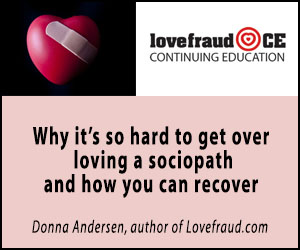









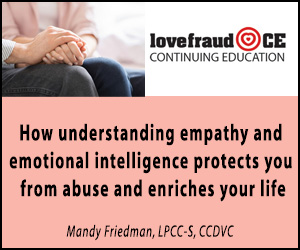






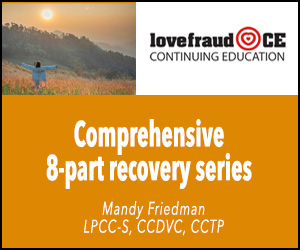
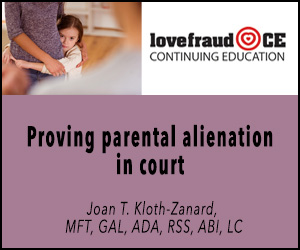


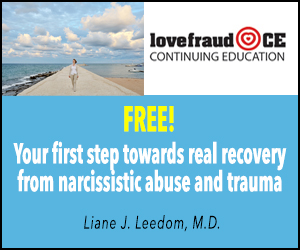

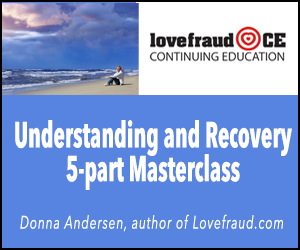

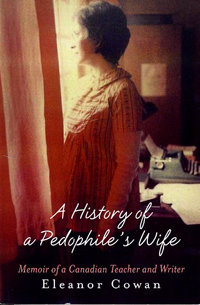 When bad behavior shows symptoms, not flaws
When bad behavior shows symptoms, not flaws 